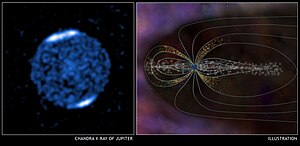Portal:Radiation astronomy/X-ray astronomy article/18

Not only are there apparently X-ray dark stars, but planets generally are not usually capable of X-ray luminescence. X-ray observations offer the possibility to detect X-ray dark planets as they eclipse part of the corona of their parent star while in transit. "Such methods are particularly promising for low-mass stars as a Jupiter-like planet could eclipse a rather significant coronal area."
As X-ray detectors have become more sensitive, they have observed that some planets and other normally X-ray non-luminescent celestial objects under certain conditions emit, fluoresce, or reflect X-rays.
Jupiter's strong, rapidly rotating magnetic field (light blue lines in the figure) generates strong electric fields in the space around the planet. Charged particles (white dots), trapped in Jupiter's magnetic field, are continually being accelerated (gold particles) down into the atmosphere above the polar regions, so auroras are almost always active on Jupiter. Electric voltages of about 10 megavolts, and currents of 10 megaamperes—a hundred times greater than the most powerful lightning bolts—are required to explain the auroras at Jupiter's poles, which are a thousand times more powerful than those on Earth.
